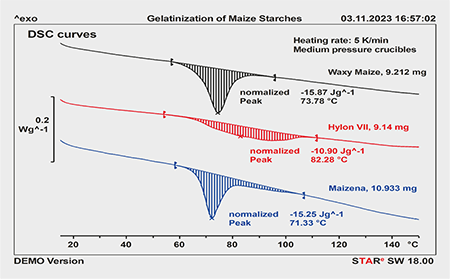The gelatinization and retrogradation of starches are important processes which for example take place when baking bread (gelatinization) and when bread becomes old or stale (retrogradation). Using different types of maize starch, we show how the retrogradation of starch can be investigated by DSC. (Maize is also known as corn in some English-speaking countries.)
Introduction
Carbohydrates play an important role in the human energy balance and are one of the most important sources of energy. Starch is a carbohydrate and the main constituent of many foodstuffs (pasta, potatoes, bread, rice, etc.). It is insoluble in water at room temperature. The gelatinization of starch is a process during which the intermolecular bonds in the starch granules break down in the presence of water and through the action of heat. This enables the starch to absorb more water and causes the starch grains to swell and burst. The crystalline content of the starch grains dissolves (amylose) or melts (side chains of the amylopectin) in the absorbed water, and the amorphous content of the starch (amylopectin) “softens”. The granular structure of the starch grains is therefore irreversibly lost and a viscous water-starch solution is formed. If the gelatinized starch is cooled, new structures (crystals, networks) form with the release water and lead to a more or less solid gel. This process is known as retrogradation. The kinetics of retrogradation depends strongly on the composition of the starch (the ratio amylopectin/ amylose), the temperature, and the water content of the gelatinized starch. The addition of fats retards retrogradation: amylose-lipid complexes are formed which reduce the availability of amylose in the gelatinized starch. Retrogradation becomes slower and the shelf life of starch-based products (such as bread) is increased [1–3]. Salt and proteins also hinder retrogradation [4]. The fat content in starch production is normally less than 1%. If gelatinized starch is slowly cooled, the formation of amylose-lipid complexes and the actual retrogradation can be distinguished from one another. In principle, this also allows the kinetics of retrogradation of fat-containing starches to be investigated.
In this article, we have investigated the retrogradation of the types of maize starch described in Table 1. The lower the amylose content, the waxier is the product.
 |
Figure 1. DSC measurement of the gelatinization of waxy maize starch (Waxy Maize), Hylon® VII and Maizena. Ratio of water to starch: 7:3. The specific enthalpies refer to the mass of the starch. |
Retrogradation of maize starches | Thermal Analysis Application No. UC 586 | Application published in METTLER TOLEDO Thermal Analysis UserCom 58



